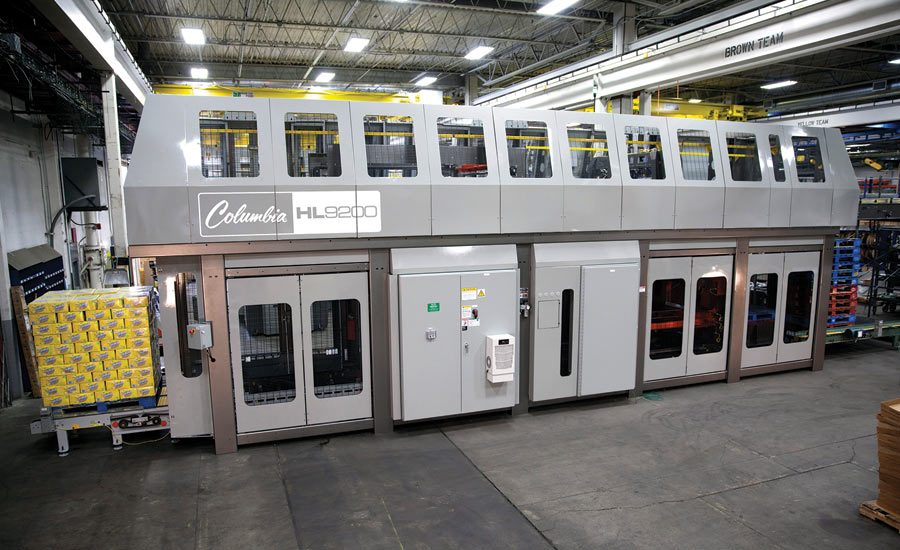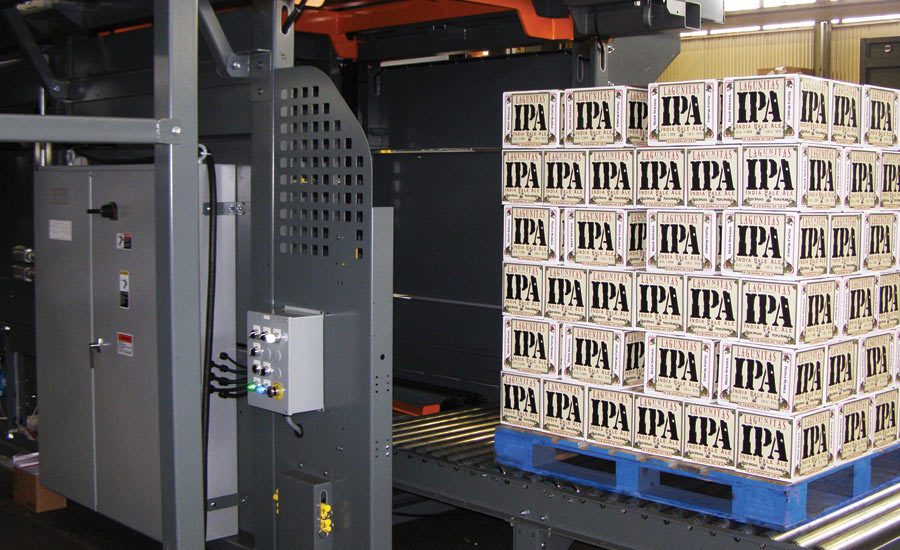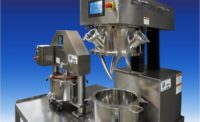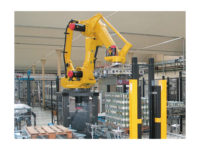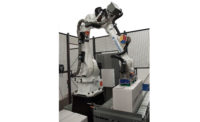Ranked among the leading mission-critical components, palletizers and depalletizers must incorporate safety, flexibility, speed and performance in order to keep operations humming along, experts say.
Shorter runs with more changeovers, less packaging and less protection for the product like shrink bundle with no corrugate tray or pad, and no dividers in glass bottle cases are among the trends impacting palletizing and depalletizing equipment, notes Ted Yeigh, sales director for Columbia Machine Inc., Vancouver, Wash.
These factors, along with diverse SKUs and smaller case sizes, necessitate the use of palletizers that can stand up to the challenges of the beverage market, he says.
“Automatic machine changeovers requiring ‘no time, no tools, no talent’ to accomplish is achievable on all Columbia palletizers including high-speed, in-line models,” Yeigh says. “Greater use of layer pre-conditioning components allows for handling of very small cases even at high speeds.
“Safety and flexibility are two very important aspects to consider when choosing a palletizer supplier,” he continues. “Additionally, the level of sophistication of the operations and maintenance staff needs to be factored in. Conventional palletizers are really very simple machines using components that are familiar to almost every type of food and beverage processor. Columbia Machine palletizers are the most flexible palletizing solution available when factoring in layout, package type, gentle handling, layer-forming capabilities and ease-of-use.”
Matt Wicks, vice president of product development and manufacturing systems for Mason, Ohio-based Intelligrated, a business unit within the Sensing and Productivity Solutions (S&PS) of Honeywell’s Automation and Control Solutions, notes that the food and beverage industry is seeking higher-quality and more serviceable machines.
“End-users are evaluating the total lifecycle costs of the equipment [and] are focused on higher-quality and more serviceable features,” he says. “We also continue to see customers with challenging types of packages (such as crates, small/light cases) as well as challenges with managing the changing palletizing pattern requirements to create stable pallet loads.”
He highlights that the company’s conventional palletizers have handled challenging product types for some time. “[O]ur engineering staff is highly competent to modify our machines to address some of the most demanding product types, so we excel in this space,” Wicks says. “We have also upgraded our 890i/891i palletizers to be even more accommodating for demanding product challenges and improved many core aspects of the machine.
“Our 890/891i conventional machines include maintenance-focused enhancements like semi-transparent covers for excellent visibility during operation [and] easily removable covers and guards for quick access to components that may require adjustment or replacement through the system lifecycle. The updated design also prioritizes safety, with an automatic air dump to avoid trapped energy, standard high-voltage arc-flash protection, remote power disconnect, interlocked access gates, taller safety fences and a muted light curtain system for pallet discharge.”
The boom in specialty beverages, one- and two-person households increasingly interested in single-serve packaging, and shorter production runs also are impacting the palletizing and depalletizing markets, says Mike Wagner, global original equipment manufacturer business manager at Milwaukee-based Rockwell Automation.
“Both trends are driving a need for palletizing and depalletizing machines that are flexible and [Internet of Things] (IoT)-enabled,” Wagner says. “A quick changeover can be a problem for traditional packaging lines arranged for a single product. Motion systems previously needed to be manually configured to handle varying speeds or intermittent motion tasks such as changing from 28-unit packs to 24-unit packs. Palletizing solutions built on smart, secure and sustainable technology can help manufacturers be more flexible in machine design and help manufacturers meet consumer trends.”
Solutions in action
As a machine supplier partner, Rockwell Automation worked with Columbia Machine to design the FL6200 high-speed palletizer, a floor-level design that combines robotic-like precision with the familiar simplicity of a conventional system, Wagner says.
Depending on the layer pattern, the FL6200 can palletize as many as 100 cases a minute while managing standard and challenging products including shallow unwrapped trays, shrink pads and film-only bundles, he adds.
Wagner also suggests that manufacturers use a common control and network architecture to simplify how the system runs, which streamlines communication from the start to the end of the line. “The FL6200 high-speed palletizer from Columbia Machine, for instance, is built on an EnterNet/IP network and control layer from Rockwell Automation,” he says. “This innovative motion-control system delivers exceptional precision and repeatability while minimizing maintenance complexity.”
Specifically designed for the beverage industry, Columbia Machine also released the HL9200, the most-advanced and highest-speed palletizer in the company’s portfolio, it says. Depending on the pattern, the HL9200 palletizes as many as 200 cases a minute. It also provides flexibility through its new variable-lane position technology by utilizing the company’s soft-turn case handling and two configurable label tables, providing accurate and stable layer forming.
“We’re the first in the conventional in-line palletizer industry to provide a [human-machine interface] (HMI) where the operator can create new patterns or optimize existing patterns via the HMI,” Yeigh says.
Additionally, Columbia Machine recently released its patented Variable Position Turner (VPT) technology, which is available for applications that are enhanced by using drop-down cushioned turners, explains Julie Lindblad, marketing and brand management specialist for the company’s palletizing division.
“The VPT technology maximizes speed and flexibility for in-line, high-speed palletizing,” she explains. “With Columbia’s VPT technology, servos are used to dynamically position the center turners laterally on an in-line palletizer while the layer is being formed.
“VPT locations are accessed and programmed via the HMI, making layer pattern additions and optimization extremely simple,” she continues.
Among the aspects that beverage manufacturers should consider when implementing automation components like palletizers and depalletizers in their warehouses are a machine’s production capacity, package handling flexibility and serviceability, Intelligrated’s Wicks says.
Cost also is a factor. “Many end-users have felt the pain of using a lower-cost, lower-quality machine and ending up with a loss of confidence in the automation and/or not seeing planned return on investment (ROI),” he explains. “The return on palletizing solutions comes in the form of labor savings and increased throughput. When considering ROI, full-machine lifecycle costs should be taken into consideration as there are many costs associated with the ongoing maintenance and use of the machinery, and a low initial price may not yield proper return, given quality and serviceability factors.”
Rockwell’s Wagner adds that a common network architecture also is crucial. “A common architecture also modernizes the data collection and analytics process,” he says. “… There is no end in sight to the need for highly flexible, connected solutions. Craft brews, personalized in-line digital direct print, and odd shapes and sizes will be pushing the palletizing and depalletizing market.” BI
